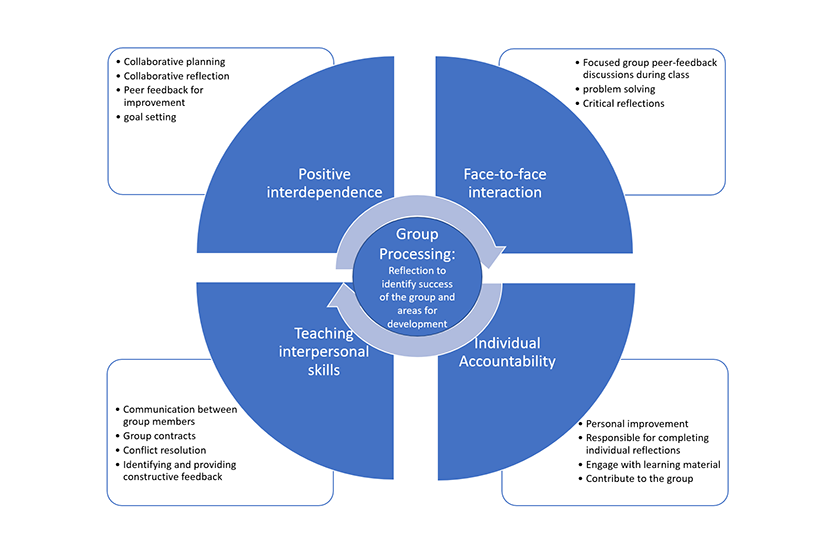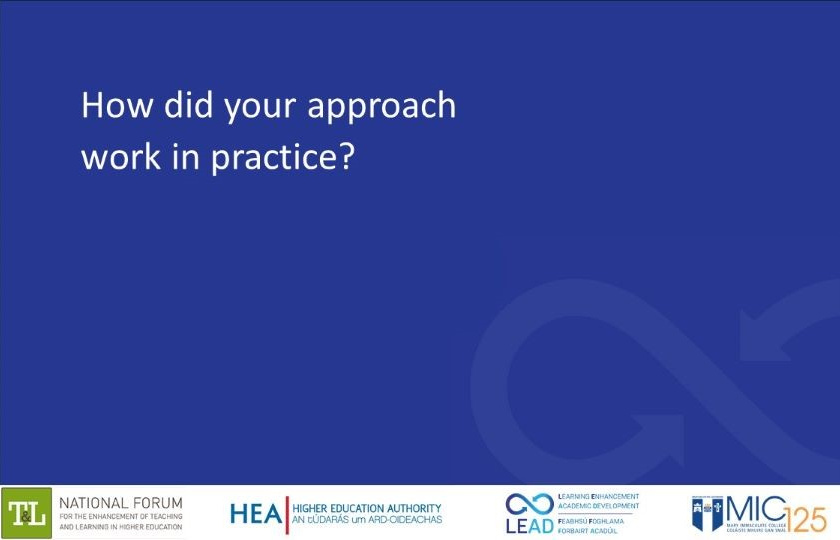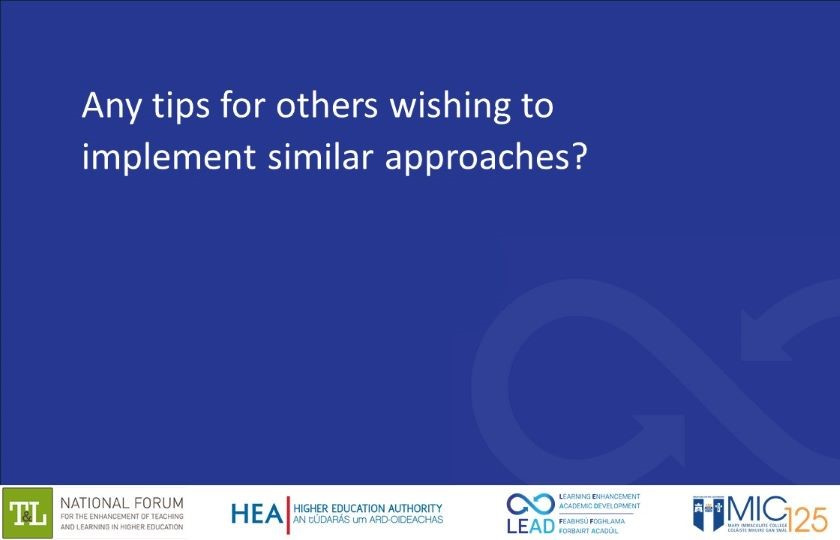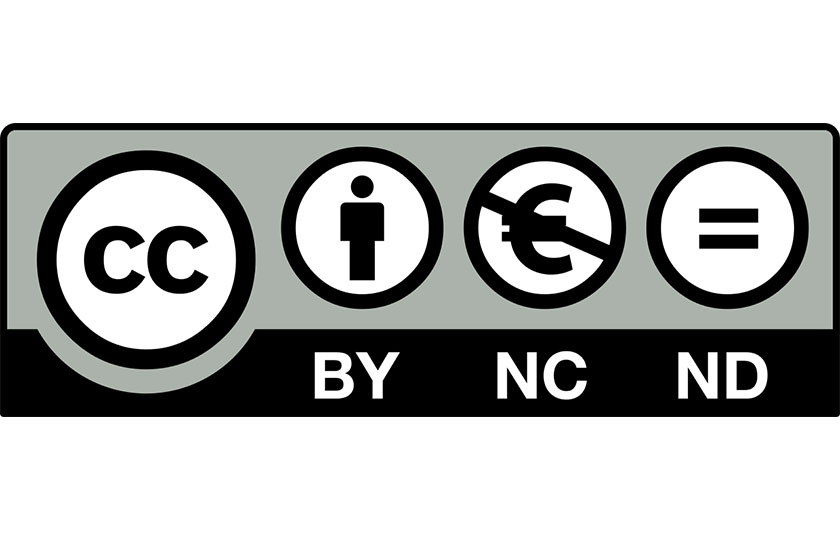Cooperative Learning within Microteaching
Cooperative Learning
| Lecturer - Dr Rosemarie Martin |
|---|
| Discipline - Initial Teacher Education |
| Subject - Microteaching |
| Level - 1st Year Undergraduate Students (Level 8) |
| Class Size - Cohort of 449 in classes of circa. 15 students |
| Mode of Delivery - In-person |
This case study outlines how Cooperative Learning was implemented within the Microteaching component of the B Ed programme during the Spring Semester 2023. Cooperative learning involves collaboration, communication and interdependence among students to achieve learning goals. Within Microteaching students were facilitated to plan, prepare, teach and reflect on their practice in collaboration with their peers.
Rationale
Developing critical reflection, and analysis skills, as well as the ability to collaborate with peers are essential for students in Microteaching. However, through my observations, I noticed that my students struggled with these skills and they lacked the trust and relationships required to provide constructive feedback to their peers. Guided by the UDL principles, the multiple means of engagement principle, in particular (CAST 2018), I identified that fostering a sense of belonging and facilitating students with opportunities for autonomy and self-regulation could enhance student engagement, communication, analytical and reflective skills – empowering them to take ownership of their learning. From my research, the cooperative learning approach seemed to be the ideal model to achieve these goals. As collaborative learning requires collaboration and critical reflection, I believed it would help to foster a sense of community within my classes.
Description of the Teaching and Learning Approach


To encourage collaboration and community among first-year B.Ed. students during Microteaching, I used Dyson and Casey's (2016) cooperative learning model. The model emphasizes positive interdependence, face-to-face interaction, interpersonal skills, individual accountability, and group reflection. Figure 1 summarizes the initiative, which involved providing learning materials in various formats in advance of classes and allowing students to complete their reflective portfolios in written or narrated format. The focus was on cooperative learning throughout the Microteaching cycle, with guidance from the tutor. Students were assessed during peer teaching sessions and on their reflective portfolios using this grading rubric available to download here. The aspects of the initiative linked to each stage of the cooperative learning model are outlined in Figure 2.

Before the first week of the module, I briefed all Microteaching tutors on the initiative and the plan for the semester ahead. In week 1, Microteaching was introduced to the students and the process of planning, peer teaching, recording, and reflecting were explained. The assessment tasks were also shared with the learners. The students self-selected groups of 3 to 4 peers, completed a peer group agreement and self-selected the weeks each group member would teach their first and second lessons.
During week two, peer groups collaborated during workshops to plan their lessons. They shared draft lesson plans with their peers for feedback and practised teaching their lessons. From weeks three to five, they engaged in peer teaching and provided constructive feedback to the teachers. The teachers and peer groups completed self assessment forms and peer feedback forms. The groups engaged in reflective discussions and helped the teachers set improvement goals. Teachers reviewed their videos and completed the second reflective portfolio task to identify their strengths, challenges, and learnings.
In weeks six to nine, the students built on what they had learned in Teach 1 and focused on more advanced learning outcomes. They followed a similar cycle of collaborative planning, peer teaching, and individual and group reflection. In week ten, they engaged in reflective discussions and shared feedback on their experiences as beginning teachers, and their experiences with the cooperative learning approach used in the module. The students then completed anonymous questionnaires to provide feedback on their learning experiences. In the final weeks of the module, they submitted their entire reflective portfolios, which included four reflective tasks that elicited their learning, development, and future goals.
What Worked and Why?

Feedback from the students indicated that they were pleased with the cooperative learning approach. Four key themes emerged from the students’ (n = 45) perspectives:
Students described supportive learning environments and a sense of community as they acknowledged great levels of support received from their peer groups, which helped them to “feel less alone” and more comfortable asking for help when needed. They felt they could practice their ideas and give and receive feedback in a safe, supportive environment. My colleagues noticed the interdependence among the groups, they specifically mentioned the sense of accountability and interdependence among the students as they had to plan, teach and reflect to a high standard, not only for themselves but to support their peers.
The students reported that the peer feedback helped them feel more confident as things they were doing well that they hadn’t noticed themselves were highlighted. Planning with their peers helped them to feel more confident in their plans and less nervous about teaching.
Students acknowledged enhanced classroom experiences by learning from and with their peers. They gained valuable insights by engaging in planning sessions, observing their peers teach and from guided feedback discussions. Giving and receiving peer feedback helped students improve their teaching and learning skills. Students reported that the guiding questions helped them to deconstruct the lessons and enabled them to focus on and identify specific features of the lesson e.g., introduction, and effective pedagogical approaches e.g., higher-order questioning, etc. They also identified important skills they gained through the cooperative learning process such as communication and social skills, collaboration and teamwork skills, evaluation and critical reflection skills. My colleagues also acknowledged that students’ teaching and planning were at a higher level than in previous years. They felt that this may be due to the support with planning they received from the resources provided, as well as working collaboratively with their peers.
Many students expressed that the guided self-assessments and reflective discussions enhanced their learning by enabling them to reflect critically. They found the forms “helpful as the questions acted as effective prompts and triggered parts of the lesson [they] may have forgotten afterwards”. They helped students identify specific successes and areas for development. My colleagues and I also noticed that the students were engaging in much deeper levels of reflection in their discussions and reflective writing. The students went beyond the descriptive level and articulated how they could progress their skills. Students were more competent in engaging in professional conversations as they were using the vocabulary from the feedback forms. It was evident that they were more aware of what success looked like and of the components of an effective lesson.
Any problems or issues that arose from this approach?
A few challenges are worthy of mention:
- Some students felt that they may have received biased peer feedback as they were in self-selected friendship groups. While group harmony is essential for effective collaborative learning to occur (Hofstede et al. 2005), randomly allocating students to peer groups may alleviate this in the future.
- While the students engaged in collaborative work throughout the module, they were not assessed on their collaborative effort, but on their individual learning through engaging in the collaborative process. Unfortunately, this resulted in a very small number of students not contributing to their peer group as effectively as others. Perhaps allocating some marks to peer group engagement and participation in future might ensure equity concerning engagement.
- It is important to carefully consider the practical elements of this type of teaching. For example, there were not enough tablet devices available to facilitate the completion of peer feedback forms online for the over sixty students in the module. As such, there was a significant amount of paper printing required. I will need to consider further options in future iterations of the initiative.
- The majority of students submitted written Word documents with very few taking up the option of presenting a narrated presentation. While I had provided resources and guidelines on creating narrated presentations on Moodle, time didn’t allow for much exploration of these skills with students during class time. Students reported that it was easier to edit a Word document rather than re-recording a presentation, so perhaps developing their recorded presentation skills throughout the semester would reduce this barrier.
Tips for Implementation

- Include relationship-building activities at the beginning of the semester. Explain the contribution of peer feedback to learning and development, how the peer feedback process will be carried out and establish group contracts and confidentiality.
- Facilitate opportunities for focused peer group engagements during class time.
- Keep peer groups small and assign specific roles and tasks each week.
- Include a variety of question types (higher and lower order questions) in peer feedback and self-assessment forms to highlight important theoretical and procedural knowledge, as well as to promote critical thinking, analysis and evaluative skills. The forms and peer discussions served as stimuli for the reflective portfolio tasks which were open-ended prompts.
- To recognise the value of their cooperative efforts, consider how it is reflected in their assignments e.g. In their reflective portfolios the students articulated the learning gleaned from their peers.
- Have students submit the self-assessment form as part of their assessment.
The cooperative learning model, in conjunction with the guided self-assessment and peer feedback forms, motivated students to learn and support each other. I will continue to develop and refine this approach in future modules with a particular focus on fostering a sense of community while developing student feedback literacy. I will continue to refine the questions so that the exercise is meaningful and effective.
To ensure that students have a real choice in expressing their learning, I acknowledge the importance of facilitating the students with opportunities to create narrated presentations throughout the semester so that this option is accessible to all students.
Another key consideration for the future is to provide the students with an opportunity to team-teach a lesson. This would ensure that the students collaborate more meaningfully through all phases of the Microteaching process.
CAST (2018) Universal Design for Learning Guidelines version 2.2. Retrieved from UDL Guidelines.
Dyson, B. and Casey, A. (2016) Cooperative learning in physical education and physical activity: A practical introduction, Routledge.
Hofstede, G. H., & Hofstede, G. J. (2005) Cultures and organizations: Software of the mind (2nd ed.). New York: McGraw-Hill.
Except where otherwise noted, content on the LEAD section of this website is licensed under a Creative Commons Attribution 4.0 International licence.
Grading Rubric
Microteaching: Assessment Rubric for Teach 1
Assignments will be graded according to the following criteria.
| Lesson Plan |
|---|
| Very Good/ Excellent (Pass) - Highly detailed – timing, structure and method. Excellent range of suitable activities. |
| Good (Pass) - Good, clear structure – identifies appropriate resources, and activities. |
| Satisfactory (Pass) - Acceptable outline of teaching method, learner activity and achievement. |
| Inadequate (Fail) - Sketchy with minimum detail. Insufficient teaching and learning activities. |
| Teacher Engagement including use of voice and eye contact |
|---|
| Very Good/ Excellent (Pass) - Teacher’s voice is excellent. It is varied to create and sustain interest. Interactions with learners ensure they are always active participants in achieving meaningful and relevant learning. |
| Good (Pass) - Good use of voice with good variation and clear enthusiasm. Interactions with learners ensure they are active participants in achieving meaningful and relevant learning. |
| Satisfactory (Pass) - Use of voice is acceptable. Teaching occasionally results in learner participation that is not active enough. |
| Inadequate (Fail) - Voice is monotonous and does not inspire interest in the learners. Teaching results in learner participation that is too passive. |
| Introduction |
|---|
| Very Good/ Excellent (Pass) - Very Stimulating introduction. Learners are motivated to learn. |
| Good (Pass) - Stimulating introduction with good level of learner motivation. |
| Satisfactory (Pass) - Brief, general introduction. |
| Inadequate (Fail) - Little if any introduction. |
| Integrating Relevant Prior Knowledge |
|---|
| Very Good/ Excellent (Pass) - Previous knowledge and experience referred to throughout. Very clear links drawn out to reinforce/promote learning. |
| Good (Pass) - Previous experience/ knowledge referred to & used to introduce new material in the lesson. |
| Satisfactory (Pass) - Some attempt made to link new material with previous knowledge or experience. |
| Inadequate (Fail) - Little or no attempt made to link new material with previous knowledge and/or experience Previous learning not checked, tested or referred to. |
Except where otherwise noted, content on the LEAD section of this website is licensed under a Creative Commons Attribution 4.0 International licence.
Microteaching Peer Feedback
Microteaching Peer Feedback Form: Teach 1
Description: Based on your observation and participation in the lesson taught, please respond to the following prompts as honestly as possible. Providing feedback to your peers will encourage you to think about teaching skills about the objectives outlined for this Teach: what went well and what could be further developed under each of the criteria outlined in the grading rubric. Guiding questions have been included to help with your reflections. The feedback you provide to your peers is crucial to their learning about how to improve their practice.
Submission: This form must be completed as soon as you have observed your peer group member for Teach 1. You will have an opportunity to engage in discussion with your peers to elaborate on the points raised. Following this discussion, you will share this form with your peer group member.
| Teach 1 - Peer Observer & Peer Response |
|---|
| 1. What, in your opinion, were the two best things the teacher did in this lesson? |
|
2. Reflect on planning and preparation:
|
|
3. Reflect on the introduction. Comment on:
|
|
4. Reflect on the learner engagement:
|
|
5. Reflect on teacher engagement with the learners:
|
| 6. If this lesson were to be taught again, what could be done differently to enhance pupil learning and/or engagement? |
| 7. What have you learned from observing this practice? |
Questions adapted from Race, P. (2001) 'A briefing on self, peer and group assessment', LTSN generic centre assessment guides series.
Except where otherwise noted, content on the LEAD section of this website is licensed under a Creative Commons Attribution 4.0 International licence.
Microteaching Self-Assessment
Microteaching Self-Assessment Form: Teach 1
Description: Based on the teaching of your lesson, please respond to the following prompts as honestly as possible. This self-assessment is to encourage you to think about your teaching skills in relation to the objectives outlined for this Teach: what went well and what didn’t, and what you might do in the future to improve. Guiding questions have been included to help with your reflections.
This assessment allows you to see how you are progressing. Please consult the learning outcomes, and the grading rubric for Teach 1 and bear the assessment criteria in mind when completing the form below.
Submission: This form must be completed as soon as you have completed Teach 1. You will have an opportunity to engage in discussion with your peers to elaborate on the points raised. Following this discussion and the analysis of your video, you can add additional responses for each point. You will submit this form as an Appendix within your reflective portfolio at the end of the semester.
| Teach 1 - Student Immediate Response |
|---|
| Add additional notes after peer feedback and video analysis. |
| 1. What is foremost in your mind following your Teach? |
| 2. What do you think was the best thing you did in this lesson? |
|
3. Reflect on your planning and preparation:
Do you think you prepared appropriate resources and were they used effectively? |
|
4. Reflect on your introduction:
Were the learners aware of the purpose of the lesson? |
|
5. Reflect on learner engagement:
Was there a balance between teacher talk and pupil activity? |
|
6. Reflect on your engagement with the learners:
|
| 7. What was the most difficult thing about Teach 1 and what could you do to work on this before you teach again? |
| 8. If you had the opportunity to teach this lesson again, what would you do differently? |
| 9. Having considered the grading criteria, what do you feel would be a fair judgement of your teaching? (Eg. Excellent/ very good/ good/ satisfactory/ unsatisfactory?) Why do you think that? |
| 10. What would you like your tutor to comment on in relation to your lesson? |
Questions adapted from Race, P. (2001) 'A briefing on self, peer and group assessment', LTSN generic centre assessment guides series.
Except where otherwise noted, content on the LEAD section of this website is licensed under a Creative Commons Attribution 4.0 International licence.
- Cooperative Learning
- Grading Rubric
- Microteaching Peer Feedback
- Microteaching Self-Assessment








